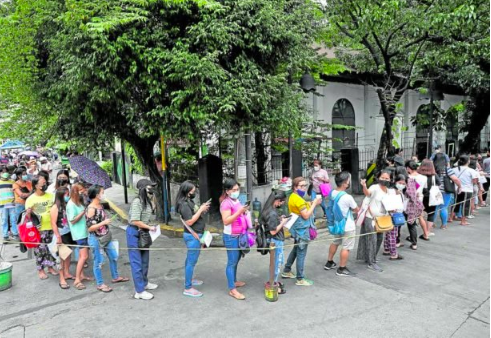
Beneficiaries of the educational assistance distributed by the Department of Social Welfare and Development (DSWD) form a more orderly queue outside the DSWD-NCR office in Sampaloc, Manila. (RICHARD A. REYES / INQUIRER file photo)
MANILA, Philippines — The Department of Social Welfare and Development (DSWD) will look into the possibility of extending the distribution of cash assistance to qualified students as well as house-to-house distribution, an official said Monday.
DSWD Assistant Secretary Romel Lopez said the agency had allocated P1.5 billion for the program and will only distribute the cash aid in the next four Saturdays or until September 24.
“If we still have the funds, we’re not discounting the possibility of extending the payout periods for our kababayans,” he said in an interview over ABS CBN News Channel.
He also said the agency would explore delivering the cash during the week, but only in select regions because each regional office is responsible for developing its distribution method.
Lopez said the DSWD initially set the payout on Saturdays since the agency also facilitates other assistance programs such as medical aid, burial aid, and the like.
“The problem is we still have a lot of programs that we cater to on a daily basis. This [educational assistance] might hamper all our programs,” he said.
Lopez said that the DSWD executive committee is set to meet again to “fine tune” the distribution guidelines, including looking into expanding and extending the distribution.
“Hindi lang namin maipangako na in all regions would be the same kasi kanya kanya na demands o kumbaga uniqueness ‘yung ating region that’s why we’re giving them a free hand to come up with an effective system to better serve our clients,” he said.
(We can’t say that all regions will be the same because they all have different needs and characteristics. So, we’re giving them a lot of freedom to devise a good way to serve our clients better.)
House-to-house distribution
To further ramp up distribution, Lopez said the DSWD might also look into doing house-to-house aid distribution, especially to those who do not have access to the internet and cannot register online.
After the debacle last August 20, where large crowds swarmed DSWD offices, the agency is now discouraging walk-ins. Instead, it would only accommodate those who have registered online and have text confirmation.
“During the pandemic, the DSWD social workers nagbahay-bahay na, this will be allotted to would-be beneficiaries who doesn’t have access to internet so that it would be fair para sa kanila. Hindi naman natin madi-discount na mayroon talagang walang access to internet,” he added.
(To ensure that those without internet connection receive their fair share of aid, DSWD social workers visited every home during the pandemic and distributed this. The possibility that some people don’t have access to the internet must not be disregarded.)
So far, the DSWD has served over 148,000 qualified students.
Up to 400,000 indigent students are expected to benefit from the program, he said.